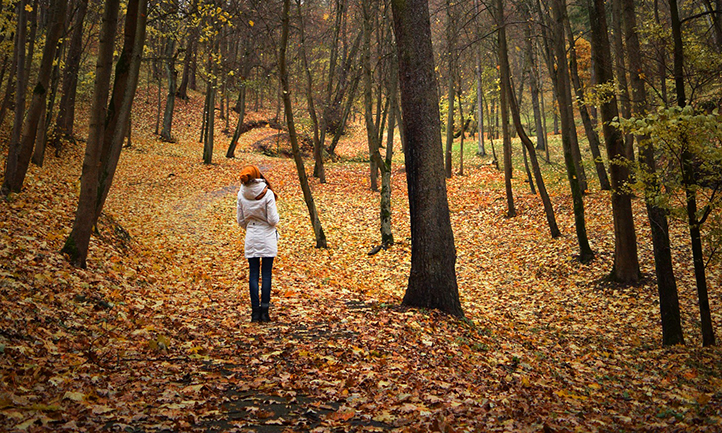Forest Bathing: Why Soaking In Nature Can Improve Your Health
Author: Emily Munoz
Forest bathing. Yes. You read that right. Forest bathing.
For an easy, self-paced mindfulness exercise, we invite you to try forest bathing.
I first heard about this Japanese mindfulness practice from my mother, Anna. She was attending one of our TAPS Inner Warrior Wellness Weekends when we posed a question to the group: How do you find quiet time? What mindfulness practices work for you?
Anna’s hand shot up, but before it had even fully extended, she exclaimed, “Forest bathing!” with a level of theretofore unseen enthusiasm. My mother is a newly-retired English professor, and my first instinct was to wince in the assumption that the adjustment wasn’t going well. My second thought, knowing that I live close to Walden Pond in Massachusetts, was she “had gone all Thoreau on me.” In fact, neither is the case.
Upon closer examination and some suspension of daughterly disbelief, we realized she was right on the money. Forest bathing is an actual thing, and we’d love for you to try it this fall as a way to connect with your inner self and the world around you.
So what exactly is forest bathing? It’s not a bath. It’s not a hike. It’s a Japanese mindfulness practice of immersion (the bath part) in nature, a way of accepting the medicine of simply being in the forest.

Known officially as Shinrin-yoku Forest Therapy, the term Shinrin-yoku means “taking in the forest atmosphere,” and, since its development in the 1980s, has become a cornerstone of preventive health care and healing in Japanese medicine. The aim of forest bathing? To slow down, take in your surroundings using all your senses and tune into the natural world.
This isn’t a new concept. People have long taken “evening constitutionals,” or enjoyed pressing the reset button by being in nature. The difference is the element of deliberate mindfulness for people who have difficulty separating the task-based world from the natural growing world. Accompanying this is a growing body of evidence that the practice helps boost immunity, improve mood and reduce stress. Undoubtedly, there are cardiovascular and mobility benefits as well, and some studies even report consistent improvements in blood pressure. You may even be able to surprise your friends with interesting “forest bathing” status updates, and we know that being able to smile and laugh boosts mood and makes coping skills more accessible.
This is a perfect time of year for forest bathing, as the seasons change and the world draws in on itself to prepare for a great opening. You bear witness to the changes in the forest — the smells of growth and decay, the movement of nature (and healing) behind the scenes, while allowing yourself time in the present.
Since forest bathing involves movement, it’s also a great mindfulness practice option for people whose energy resolves with activity rather than rest. So, find a forest or a stand of trees, and go get your feet wet (so to speak).
How does one “go” forest bathing? Here are some ideas.
- The principles of forest bathing are breathe, relax, wander, touch, listen and heal. Keep these in mind as you choose a location that will allow you to safely engage all of your senses. Avoid places that are negative emotional triggers, and remember that forest bathing is about where you are, mentally and physically, right at that time.
- Make a plan based on your daily physical activity; i.e., it’s better to go when you’re not physically depleted if you’re not used to exercising or uneven terrain. Remember this is not about exertion — if you feel tired, you can take a rest anywhere and anytime you like.
- Bring water or tea and hydrate as you need.
- Leave behind your phone or other distractions, or turn them off or in “do not disturb” mode. Leave fitness watches, step trackers and other devices at home.
- If you choose to sit and read, it may be helpful to take along meditations or devotionals, poetry, prayers, etc.
- Leave behind your goals and expectations. Wander aimlessly, allowing your body to take you wherever it wants.
- Pause from time to time, looking closely at a leaf or noticing the sensation of the path beneath your feet. Remember to touch and smell; use all your senses.
- Find a comfy spot to take a seat and listen to the sounds around you. See how the behavior of the birds and other animals changes when they become used to your presence.
- If you go with others, make an agreement to resist talking until the end of the walk, when you can gather to share your experiences. If you’re going with a guide, he or she may offer some guided meditations.
- Tell someone where you’re going and when you plan to return. Make sure to take a map if you’re worried about getting lost, but remember that forest bathing isn't about covering distance. Walking to reach a step goal or cover ground reinforces a focus on outcome, not experience.
Emily Muñoz is the surviving spouse of Capt. Gilbert Muñoz, U.S. Army and serves as the TAPS Women's Empowerment Director.
This article was first published on the TAPS website in October, 2017.
Resource: Association of Nature & Forest Therapy
